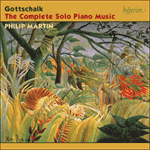Gottschalk astonished audiences with the exotic, syncopated rhythms of the Caribbean which he incorporated into such pieces as
Les yeux créoles (Ojos criollos) (recorded on CD 1),
Manchega (recorded on CD 2) and
Bamboula (recorded on CD 3). As early as the Civil War, Americans were given a foretaste of the popular music that was to develop two generations hence. But whatever the rhythm, their craving for lively, vibrant music was insatiable and Gottschalk duly obliged.
La Colombe is a sparkling salon polka reminiscent of his
Polka in A flat (RO275) and, thematically, his own celebrated
Ojos criollos.
from notes by Jeremy Nicholas © 2000
Gottschalk stupéfia les auditoires en introduisant les exotiques rythmes syncopés des Caraïbes dans des pièces comme
Les yeux créoles (Ojos criollos),
Manchega et
Bamboula. Dès la guerre de Sécession, les Américains eurent donc un avant-goût de la musique populaire qui allait se développer deux générations plus tard. Mais quel que fût le rythme, leur soif d’une musique vibrante, pleine d’entrain était inextinguible et Gottschalk, bien sûr, l’apaisa.
La Colombe, étincelante polka de salon, rappelle sa
Polka en la bémol (R0275) et, thématiquement, ses célèbres
Ojos criollos.
extrait des notes rédigées par Jeremy Nicholas © 2000
Français: Hypérion
Gottschalk erstaunte sein Publikum mit den exotischen synkopierten Rhythmen der Karibik, die er in Stücke wie
Les yeux créoles (Ojos criollos) (siehe Einspielung auf CD 1),
Manchega (siehe CD 2) und
Bamboula (siehe CD 3) aufnahm. Schon im Sezessionskrieg erhielten die Amerikaner dadurch einen Vorgeschmack auf die Richtung, welche die populäre Musik zwei Generationen später nehmen würde. Ungeachtet des spezifischen Rhythmus’ war ihre Lust auf beschwingte, lebhafte Musik jedenfalls unersättlich, und Gottschalk war ihnen gefällig.
La Colombe ist eine funkelnde Salonpolka, die an seine
Polka in As-Dur (RO275) erinnert und vom Thema her mit seinen berühmten
Ojos criollos verwandt ist.
aus dem Begleittext von Jeremy Nicholas © 2000
Deutsch: Anne Steeb/Bernd Müller


 Gottschalk: The Complete Solo Piano Music
Gottschalk: The Complete Solo Piano Music
